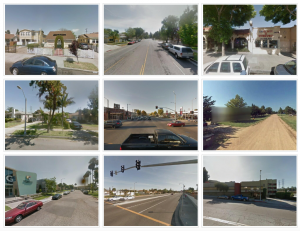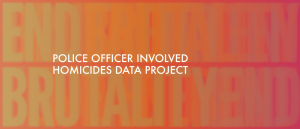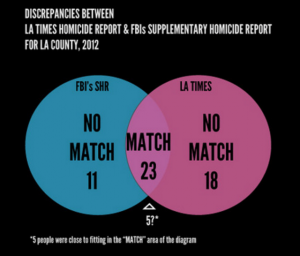The POI Homicides Database Project entails collaborative research and events organized by myself and three other students from UCLA’s Information Studies Department: Brittany Paris, Irene Pasquetto, and Jennifer Pierre. We explore un- and under-reported incidents of police officer involved (POI) homicides, both justified and unjustified. To fill gaps found in existing government and local databases pertaining to POI homicides, we deploy participatory action research methods through community involvement in mining and analyzing social media data related to these incidents. Through these methods, social media information operates in concert with publicly available government and local databases to create a clearer representation of the lived realities of communities experiencing police homicides in the United States. Los Angeles County is our community of study.
The POIH Data
The project analyzed three federal datasets and two local datasets, available for download at this webpage.
- The Supplementary Homicide Report
The SHR is a database curated and publicly diffused by the Federal Bureau of Investigation (FBI) which contains information about particular kinds of offenses committed up till 2012, defined by the FBI as: “Murders and Non-negligent Man Slaughters, including justifiable homicides”. Navigating its 152 variables and 13,063 entries, it is possible to narrow the research just to those justifiable homicides in which the victim was killed by a police officer. - Wide-ranging Online Data for Epidemiologic Research
The CDC provides information regarding causes of death in its Wide-ranging Online Data for Epidemiologic Research (WONDER) database. This data is collected by the National center for Health Statistics and provided to the WONDER database. Data are based on death certificates that identify the cause of death and demographic data for United States residents. National, state and county mortality data by underlying cause and up to twenty multiple causes of death are available for each death certificate. Data are available by age group, race, and sex. Cause of death is specified by ICD 10 codes. Data are updated annually. - Arrest Related Deaths
ARD provide state-level statistics from 2003-2009 on the circumstances of deaths that occur during, or shortly after, state or local law enforcement officers engage in an arrest or restraint process. In the Bureau of Justice’s interpretation, arrest related deaths include any time “a person is in the custody or under the restraint of law enforcement officers” – whether or not a formal arrest process was intended. Federal law enforcement were excluded from the tables. - Los Angeles Times Homicide Report
This site documents and maps homicides reported by the LA Times in LA county. One can filter according to a number of parameters, including “only officer involved” to show those that were perpetrated by cops. The LA Times hosts The Homicide Report as a part of its interactive data journalism component, the LA Times Data Desk. This site documents and maps homicides reported biweekly to the LA Times by the coroner’s office of Los Angeles county. - Youth Justice Coalition
A PDF document that reports cases with name, age, race, location and where possible incident details from January 1, 2007 – August 31, 2014.
The Police Brutality Hackathon
[Flyer by Brittany Paris]
With the UCLA Information Studies Department we organized a Hackathon on Police Brutality Data in Los Angeles County on Saturday February 14th, 2015, from 12 pm – 6 pm. The event engaged those interested in community organizing, social justice, hacking, data mining with the unique and imperfect datasets regarding police brutality in LA County. The hackathon examined how police brutality data is captured and disseminated among state and federal organizations and worked to bring attention to the existing data, as well as the holes in existing data, through data mining, discussion and visualization.
The event kicked off at noon with pizza and a panel of speakers from the LA Times‘ Homicide Report, USC’s Innovation Lab and the Stop LAPD Spying Coalition. Following the panel discussion, we broke into sessions related to data analysis, social media analysis, GIS mapping, and a policy discussion. The hackathon’s projects results can be viewed here and some examples are below:
[LA Times’ Homicide Report Comparison to FBI’s Supplementary Homicide Report in 2012.
By Vivian Lam, Brandon Lam, Courtney Lee, Richa Shah.]

[Google Street View Images of Addresses where POIH Occurred. By Daniel Schwarz and Visualization Team. The team scraped images from Google Street View based on address data from the Youth Justice Coalition. Sample of 9 from over 335.]
Credits
Project leads: Morgan, Brittany Paris, Irene Pasquetto, and Jennifer Pierre. With faculty support from Professor Leah Lievrouw and a grant from the 2015 iConference Social Media Expo.
Bibliography
Currie, M., B. Paris, I. Pasquetto, and J. Pierre (2016). The conundrum of police officer-involved homicides: Counter-data in Los Angeles County. Big Data & Society. 3.2: 2053951716663566. bds.sagepub.com.
Currie, M., B. Paris, I. Pasquetto, J. Pierre, and A. Sands. (2015). The Police officer-involved homicide database project. Proceedings to the 2015 iConference, Newport, CA.


